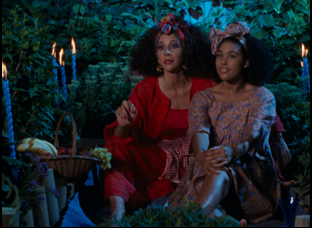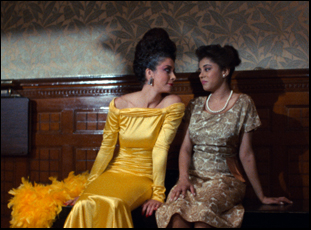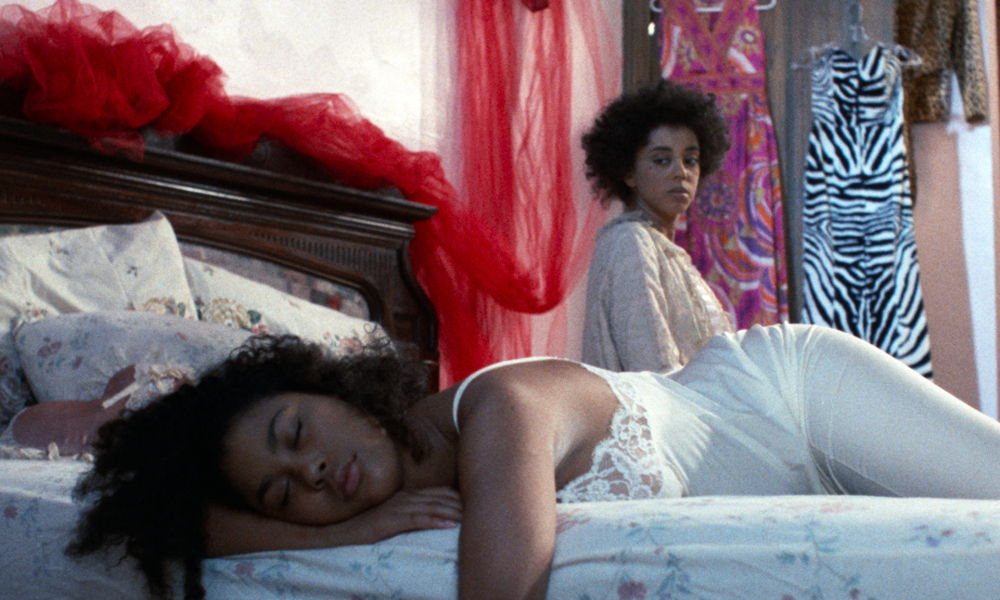There was only so much room to celebrate during a key scene in “Alma’s Rainbow” where Alma Gold (Kim Weston-Moran) invited the whole neighborhood to her place to commemorate the 10th anniversary of her beauty salon in Brooklyn. This being a scrappy independent production, writer/director Ayoka Chenzira had limited space for a fitting party, although that was hardly going to curtail the energy she wanted in the film, working out a plan with her crew to bring in the friends, family and friends of friends she had invited in for the day to a holding area down the street where they could practice dancing and slowly bringing them to set. The only question remained was what kind of dance could be done to that would be exuberant yet nimble at the same time.
“The house is beautiful, but that living room is narrow, so the perfect dance for it seemed to be the limbo,” says Chenzira. “It fit very well in that space.”
Chenzira shows a knack for finding joy in the most unexpected of places throughout her feature debut, made after she had accumulated a wealth of experience in a number of artistic mediums from dance to animation. Even now nearly three decades after its initial release, “Alma’s Rainbow” is a revelation, particularly when a new restoration by Milestone Films has rejuvenated the vivid color palette that grew a bit pale when the film could only be seen mostly on VHS, though its vitality has never been in question with how Chenzira was able to capture the restlessness of the three women in the Gold family, the enterprising Alma, her teenage daughter Rainbow (Victoria Gabrielle Platt) and her sister Ruby (Mizan Kirby, née Nunes), whose showbiz aspirations could infect Rainbow as she pursues dancing, much to her mother’s dismay.
Rainbow’s coming of age is central to the film, caught between the wholly different attitudes towards life in looking up to her more responsible mother and her impulsive aunt as well as struggles with her own body as physically becoming a woman threatens to upend the mostly male friendships she has, but Chenzira, who slyly alludes to transference and equity in the film’s title, shows these anxieties aren’t the teenager’s alone, with Alma left to wonder if the discipline she’s imposed on herself to run a business and keep a roof over her head has deprived Rainbow and herself of greater happiness and Ruby experiencing the self-doubt of anyone pursuing a career in the arts, in spite of the brave face she puts on.
The filmmaker’s radiant curiosity about the lives of all her characters extended to her formal daring in the years to follow, leaving “Alma’s Rainbow” as her sole big screen feature, but venturing into other realms that prized interactivity as she turned her script “Flying Over Purgatory” into a stage production that could cut across space and time to create a dialogue between the past and present in uniting stories of post-apartheid South Africa and the 1960s civil rights movement in America and embracing digital media to create “HERadventure,” a sci-fi saga that employed YouTube to allow audiences to continue the story after her own work on the film had ended.
With “Alma’s Rainbow” beginning a theatrical run across the country, launching at BAM Rose Cinemas in Brooklyn this week where the film will be accompanied by Chenzira’s 1984 animated short “Hair Piece: A Film for Nappyheaded People” (as well as the director herself on opening night July 29th), the filmmaker spoke about how she poured herself into her narrative debut and incorporated her love of dance into the stories of women trying to find the right steps forward in their lives.

I am still floating on cloud nine because the restoration is just beautiful. The film was designed for large screen projection and there haven’t been a whole lot of places that have shown the work large scale. I’ve seen it at a few festivals many years ago, but this looks like the film that I made and I had originally imagined.
You worked in a number of different artistic modes before getting to “Alma’s Rainbow.” Had a narrative feature been something you had as a goal or did it come about organically?
It really just organically happened. I come first from documentary and then I discovered from a formal standpoint, it felt very narrow. At the time I discovered I really liked processes, so I spent a lot of time experimenting with the celluloid, but when video came, I felt I could come up with things in my imagination faster and even had my imagination expanded because of that instantaneously replay or being able to do a lot of collages and map images on top of each other. That was really a world that I cherished and reveled in and I began thinking more and more about fiction short stories, which organically took me into my first feature. I was writing it really for myself, mostly on the New York City subway and there was no time pressure. I wasn’t trying to get it to anybody, but the next thing I know, somebody said, “You should apply to Sundance.” [laughs] And I said, “Sundance? What’s that?” And for the first time, I was suddenly writing for a deadline.

There are parts of this that are autobiographical. My mother did own a very beautiful beauty parlor, which is really my introduction to storytelling and particularly storytelling from a woman’s point of view. My mother also took me to every age inappropriate movie because she loved, loved, loved the movies. [laughs] That’s one part of the story I wish we had been able to film, but the tensions in the film aren’t quite mine. I’m probably one of the few American children where the parent actually wants you to be an artist, so I was exposed to a variety of art forms at a very early age because my mother very much wanted to be an artist. In many ways, she was. She made extraordinarily exquisite clothes.
But I think the mother/daughter tensions are universal. Listening to these stories in my mom’s beauty parlor as a very young kid and then early teens, I learned a lot about what women were going through. It was everything from very wonderful things to things about their jobs, domestic violence and racism and police brutality. And when I was preparing to write the story, it was coming out of interacting with young people and their moms where the relationships, it was clear to me were just stuck, and part of that being stuck was because on the one hand, the mothers didn’t know what to do. They had given their lives over to raising their daughters and to this brand of mother and what mother looks like and stopped growing in the process, which means that the best they could do is try and control their daughters as opposed to helping them go onto this next phase of their teenage journey.
It’s interesting also how Rainbow also isn’t entirely comfortable in her skin – she doesn’t know what to do with this body that she has, and it seems to be way ahead of a conversation that’s happening now. When there wasn’t necessarily words for it at the time, was that difficult to depict?
One of the things that caught my attention [in having these conversations at the time] was, at some point, girls are looking at boys and boys are looking at girls and I decided that I had male friends and playmates and I did not want that to change, so I was what they called a tomboy at the time growing up, — I was very good at sports and when my body began to change, I didn’t want anybody to notice. I didn’t want to talk about my body, I didn’t want anybody to notice. I just wanted to be in this tomboy world and I remember even really late into my teens wearing clothing that really didn’t show off the body very much.

Yeah, I’ve been dancing since I was four years old and in fact, it remains my favorite art form to this day because I continue to be surprised and delighted and in a state of wonderment when you just think about what the body can do and how it can communicate nonverbally, and my mother had an incredible sense of rhythm, so it’s very much in my DNA. At that time in New York and a lot of different parts of the country, you see a lot of street dancers and kids form dance groups and perform on the street for money and that becomes kind of her safety space and because I came from modern dance and did African dances and Caribbean dances and the Katherine Dunham technique, they just felt natural and right for the story. And Thomas Pinnock, who was my first husband, was a born choreographer and dancer – rhythm just exuded out of him all day every day, so I really couldn’t think of anybody other than him doing the movement for the film.
What was it like to find the three women who played the Golds?
I found Victoria Gabrielle Platt in an audition, and she was the person who told us about Isaiah Washington [who has a bit part in the film], but Kim Weston-Moran was the reader at the casting sessions, reading the sides with the actors that we were auditioning and one day she was reading and I looked at her and I said, “You should play Alma!” [laughs] So that’s how she got Alma. And then for the role of Ruby, Cassandra Wilson, the singer/songwriter, was cast in the role – and at the last minute, Cassandra got a really wonderful contract to sing and to tour, so she came to me and I said, “I get it,” and we let her out of her contract because it was the right thing for her. Then we had to find a Ruby and everyone said, “You should go talk to Mizan Nunes, she is Ruby.” Someone made a call and the next thing you know, I went to her apartment on the Lower East Side and she auditioned for me in her apartment and got the role.
Beyond the cast being the right fit, they all had wonderful outfits. Was that your mother’s influence as well?
Yes, I was fortunate to have a wonderful costumer Sidney Kai Ennis, who read the script and got it immediately. She has a marvelous sense of colors and patterns and shape and form and that was really helpful to me because I grew up with a mother who made everything. She made beautiful clothes, which I didn’t appreciate at the time and she would go fabric shopping on the weekends and take me with her. She would also buy vogue patterns and Butterick and a company called Simplicity would redesign those patterns, and even though I didn’t have an appreciation for it as a child, what I came to understand as an adult is that I have a good sense of clothing, color, texture. I also think growing up in the Catholic Church where you have these big rituals at the time when I was growing up, it’s like costume drama. [laughs] it’s just a beautiful display of colors and patterns and display and ritual, so that very much is still a part of how I see the world.

Because the actress didn’t show up. And time is a ticking. [laughs] And the costume was there and I fit the costume. That was it.
What’s it like now to look back on?
It’s still kind of an out-of-body experience. What my husband said I’m experiencing is time travel because the distributors Kino Lorber and Dennis [Doros] and Amy [Heller] at Milestone, in particular were able to pull together the cast and some of the crew to the BAM screening and I haven’t seen those people, except for Jean-Paul Bourelly, who did the music, for about 28 years. And seeing this film that we all worked on projected in the way I always imagined – and by the way, it’s the first time I’ve heard it with stereo sound, so suddenly, I could hear, really hear the richness of things – it just took it to another level. Jean-Paul Bourelly’s compositions are really extraordinary. I could hear the sounds, I could hear the sound effects and it was truly an immersive experience. And now it’s about to travel and I still haven’t settled into how extraordinary this all is. I always say that the right thing happens for you at the right time, but I will say that I was not fully prepared for what a powerful and beautiful experience I’m sitting in right now.
“Alma’s Rainbow” opens on July 29th in New York at the BAM Rose Cinemas and August 12th in Los Angeles at the Monica Film Center, preceded by a special screening on August 7th at the Los Feliz 3 with a Q & A with Victoria Platt and editor Lillian Benson. A full list of theaters and dates is here.




